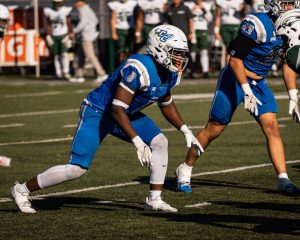Was ‘All The Bright Places’ Worth The Wait?
March 10, 2020
The short answer is no, the movie adaptation of “All The Bright Places” was not worth the five year wait.
I will warn readers now that “All The Bright Places” contains topics such as depression and suicide, so if those are sensitive topics for you, proceed with caution.
“All The Bright Places” was first released as a young adult novel by Jennifer Niven on January 6, 2015. If you were like me, in 2015 you read every young adult romance novel you could get your hands on. That being said, I couldn’t wait to see the movie, and lucky for me IMDB stated it would be released in 2017.
But then the release date kept getting pushed back further and further. And instead of increasing suspense, the delays only decreased my interest.
The movie adaptation of “All The Bright Places” was finally released on February 28, 2020 but it was hard to watch.
I will disclaim that my standards for entertainment are higher now than they were in 2015, as I’m sure is the case for a lot of you as well. Therefore, it may not be the movie’s fault if I find it fell short, since it was based on a book written five years ago.
Many of the lines came across as fake or cheesy and the way information was conveyed to the audience felt forced. In one scene, Finch asks his sister where their mom is, and she replies, “She had to go to Chicago for business, remember?” to which Finch responds, “Oh yeah, right.” He conveniently forgot his mom’s big business trip so the viewers could learn that mom is absent a lot of the time for work.
There are also those classic cliches, like Violet saying her biggest fear is being ordinary, even though she seems far more afraid of cars if you ask me.
Something about Elle Fanning’s acting made me uncomfortable throughout the movie. Violet is meant to be a sad character since she lost her sister in a car accident, however, I never believed Fanning was upset.
Fanning’s co-star Justice Smith exhibited great acting skills. I just don’t believe he was right for the role of Finch. In the book, Finch was known as the depressed freak at school. However, in the movie, Finch was far too charismatic and bubbly for me to believe everyone in the school either didn’t like him or was afraid of him.
Smith has been featured in several other young adult novel movie adaptations recently, such as John Green’s “Paper Towns” and David Levithan’s “Every Day,” which is most likely why he landed the role of Finch. But he is not meant to play a “freak” with depression and bipolar disorder.
And of course, there is the classic complaint that they changed aspects of the book when turning it into a movie. Nothing drastic was changed, but I was upset that small memorable scenes like Violet and Finch expressing their desire for one another through sticky notes on Finch’s closet wall were missing. Also, Finch never calls Violet “Ultraviolet ReMarkeyable” in the movie, which was a huge disappointment.
Don’t get me wrong, there are endearing moments, like when Finch and Violet stand at the tallest point in Indiana, which ends up being quite underwhelming. Or when they ride a tiny rollercoaster in a stranger’s backyard.
But just as he does in the book, at the end of the movie, Finch succumbs to his mental illnesses and drowns himself. Violet and Finch’s friends attend the funeral, heartbroken, sending the message that you will be missed if you take your life, even if some people call you a freak.
The movie ends with a disclaimer, stating, “This film is dedicated to those who have been impacted by mental health concerns, suicide or grief. If you are struggling or know someone who is, you can find more resources at allthebrightplacesfilm.info.”




